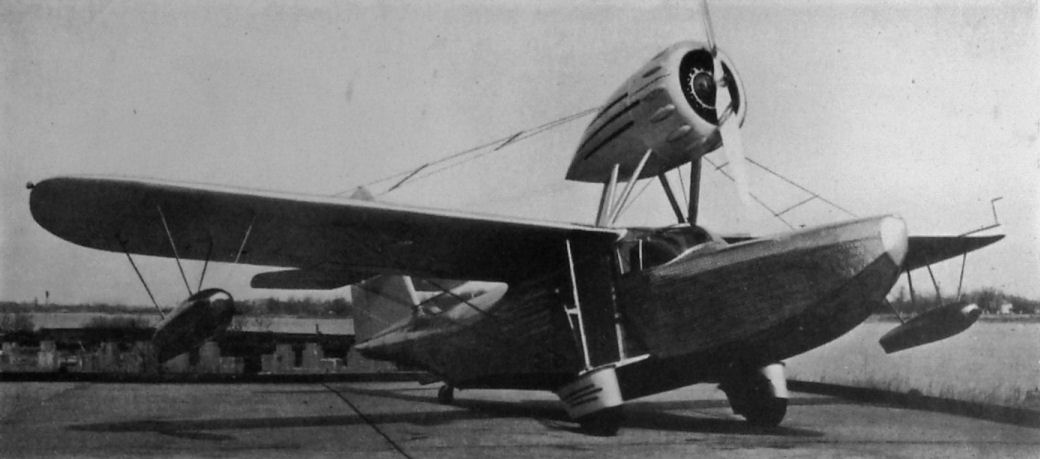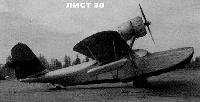Fleetwings F-5 Seabird
Компания "Fleetwings" была основана в Бристоле, штат Пенсильвания, в 1929 году и первоначально занималась изготовлением различных конструкций из нержавеющей стали. С обретенным в этой области опытом компания стала изготавливать компоненты из нержавеющей стали для Армии и ВМФ США, а также для ряда американских авиастроительных фирм.
"Fleetwings", как и многие изготовители стальных конструкций, попыталась проникнуть в авиапромышленность, спроектировав и построив гидросамолет из нержавеющей стали. В результате получился подкосный высокоплан Fleetwings Seabird с двухреданным фюзеляжем - лодкой, увенчанным высоким килем. Самолет оснастили убирающимся шасси с хвостовой опорой, а под законцовками крыла поставили поддерживающие поплавки. Звездообразный мотор Jacobs в обтекаемой гондоле установили на стойках над центропланом. В отдельной кабине сидели два пилота, в салоне за ними - два или три пассажира.
Прототип Seabird F-4 впервые поднялся в воздух в 1937 году. Он неплохо летал, но на довольно дорогой аэроплан ограниченной вместимости поступило мало заказов. Построили только пять серийных амфибий F-5.
ТАКТИКО-ТЕХНИЧЕСКИЕ ХАРАКТЕРИСТИКИ
Fleetwings Seabird F-5
Тип: пятиместный пассажирский гидросамолет-амфибия
Силовая установка: поршневой семицилиндровый звездообразный мотор Jacobs L-5 мощностью 285 л. с. (213 кВт)
Летные данные: максимальная скорость 241 км/ч на уровне моря; крейсерская скорость 224 км/ч на высоте 915 м; практический потолок 4420 м; дальность полета 837 км
Масса: пустого самолета 1134 кг; максимальная взлетная 1724 кг
Размеры: размах крыла 12,34 м; длина 9,75 м; высота (на колесном шасси) 3,81 м; площадь крыла 21,83 м2
Показать полностьюShow all
Flight, October 1936
A SHOT-WELDED, STAINLESS STEEL AMPHIBIAN
The American Fleetwings Seabird: Unusual Undercarriage Arrangements
CONVINCED of the suitability of stainless steel as a structural material for aircraft, Mr. Carl de Ganahl and his chief engineer, Mr. W. A. Sutton, have used this metal at the Fleetwings plant, Bristol, Pennsylvania, for the construction of an amphibian monoplane with some interesting features. As our American contemporary Aviation puts it, it is the first attempt to design from scratch in stainless steel. It may be recalled that some years ago a small Savoia Marchetti amphibian was "translated" into this form of construction.
Except for the fabric covering of the wings and tail surfaces the structure is of stainless steel, welded throughout. The hull is a composite type in that it is part monocoque and partly of steel tubing. The true monocoque portions come fore and aft of the cabin section. Their cross-sections are maintained by light former rings joined fore and aft with light stringers to which the steel skin is shot-welded.
Of conventional two-spar type, the wings have relatively light intermediate ribs and built-up drag struts and double diagonal tie-rod bracing. Flat plates, shot-welded against the webs, provide points for attachment for terminals and the external wire bracing. The ailerons and flaps are carried on ball-bearing hinges cantilevered out behind the rear spar.
The flaps are hydraulically operated from the same double-acting pump which handles the retractable undercarriage. They are pumped down, and will hold their position at any angle from o to 60 degrees. On being released by the operation of the appropriate selector valve on the instrument panel they are automatically returned to the "up" position by the combined action of springs and air pressure.
The design of the fuel tanks is also of more than usual interest. One tank is placed in each wing, and as the wing section is thin, the tanks must be very flat. Corrugated sheet with the corrugations running span-wise is chiefly employed, the end plates are made by drawing scalloped edges which are made up with the sheet corrugations. The final assembly is by shot-welding. These tanks weigh only 14.5 lb. each, including fittings which, considering that they hold over 19 gallons each, is a creditable figure.
The prototype machine is fitted with a Jacobs radial of 285 h.p. mounted on Lord shear-type rubber bushings.
Access to the cabin is through a hatch of the centre section of the wing; steps and retractable hand-holds are provided.
An Unusual Undercarriage
The treatment of the land undercarriage is another feature of interest. Tests in the wind tunnel have shown that when this is retracted the drag is very low and it is claimed that there are no disturbing aerodynamic effects from interference or other causes. The undercarriage is arranged so that when the wheels are in the "up" position they are housed laterally in their streamline casings, giving the appearance, in flight, of very small wing stubs. The wheels are in full view of the pilot at all times and their retracting gear is operated by a hydraulic hand pump.
The following are the main data: Weight empty 2,285 lb., gross weight 3,415 lb., wing area 235 sq. ft., power loading 12 lb./h.p., wing loading 14.5 lb./sq. ft., maximum speed over 150 m.p.h., cruising speed 135 m.p.h., service ceiling 15,000ft. and normal range 450 miles.
Показать полностьюShow all



